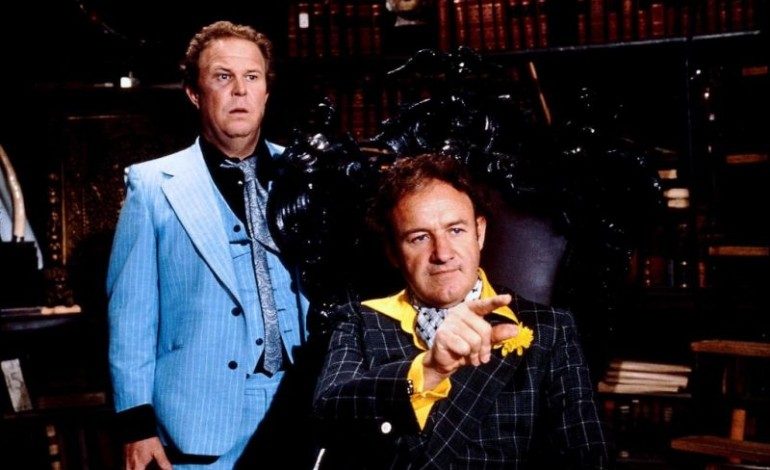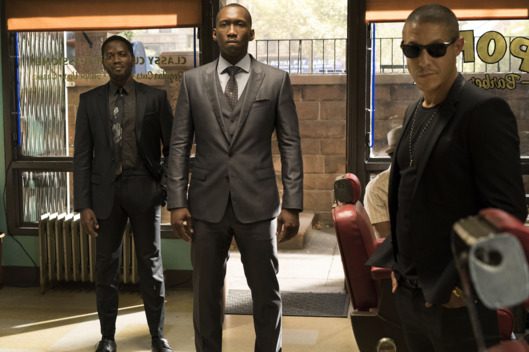

For all of the successes of comic book movies, there’s been one major area (well two) that they haven’t been mostly successful at – the villain. It’s a problem identified by nearly everyone, from Fans to Feige, and it’s a problem affecting not just the Marvel Cinematic Universe, but WB and Fox as well. (Though when it comes to discussing comic book movies as a whole, it’s a lot easier to focus on Marvel for obvious reasons.) While there are a few positive stand outs, for the most part we get revenge-seeking madman (or mad witches) or a CGI monster with a space laser.
So what could work for a villain? Who knows? For every “rule” I can come up with, there’s an exception. And for everything that works, it would defeat the purpose to see the same thing repeated time and time again. However, seeing what has worked can provide a broad idea of how to approach ne’er-do-wells in the future. (Spoilers for superhero properties up to and including Luke Cage.)
What appears to be a virtually universal constant in creating a good villain is that he/she must have a rich inner and outer life. Put another way, in the same way we can imagine heroes existing outside of a singular villain, we should be able to imagine villains existing independent of their heroic foil. One of the major reasons Netflix has succeeded with the likes of Vincent D’Onofrio’s Wilson Fisk/Kingpin, David Tennant’s Kilgrave, Mahershala Ali’s Cornell Stokes/Cottonmouth, and Alfre Woodard’s Mariah Dillard is that these characters feel as though they come with their own personal universes that they’ve built up over years; the hero ends up being a thorn in their sides rather than the other way around. If they succeed in their goal to stop the hero, we want to believe that they’d still exist and go about their lives. When you can’t believe in the villain as a character, then there’s no actual character and thus a good portion of the dramatic tension is obliterated from the start.
Understandably, time plays a major factor towards this. Movies have around two, two-and-a-half hours to pull off a full film with multiple storylines, plus the need to constantly one-up the previous one with effects, action, and fighting. Netflix series have lower budgets plus more time to fill, which means that the showrunners have the opportunity/the necessity to delve into their villain’s backstories more, and these often get as much relevance as the good guys’. Now sure, most villains have some kind of conventional tragic backstory, but even with similar marks getting hit most of the time, we nevertheless get a richer character for it. Humanizing the “bad guys” and giving them a modicum of intelligence allows us to understand the personal reasons that drive heroes and villains alike and enriches the relationships between them and the greater world. It’s not simply a generic mustache-twirling villain plopped in to give the hero something to do or a roaring CGI monster with a space laser whose major purpose is destroying cities.
In addition to receiving a superior history, they also get a fuller present. The audience gets a better sense of how the villain operates, their plans, their motives, and their schemes. We’re not left wondering “Wait? Was Guy Pearce the guy behind everything that happened in Iron Man 1 or did he just co-opt the 10 Rings moniker for Iron Man 3?” Another extra benefit is side characters. The main hero works best when he has a crew to play off of – your Alfreds, your Foggys, your Rhodeys, your Falcons. The same is true for villains. Characters such as Shades in Luke Cage or Owlsley in Daredevil who are henchmen for the main bad guys would barely get a couple of lines in a movie, whereas they get to become stand-outs in their respective series while enhancing the main villain and thus the world.
Another reason why villains have failed to live up to their expectations is violence. With most movies aiming towards a PG-13, more family-friendly-ish vibe, we rarely get to see these antagonists indulge their bloodlust. It’s partly why The Joker has become such an important comic book movie character – whether it’s shooting his number one guy, doing the pencil trick, or probably a bunch of cool stuff cut out of Suicide Squad, he’s willing to get his hands dirty. Most of the dastardliness that other comic book villains do are mostly done off screen or shielded from the audience or devolve into muddled CGI confusion. With Netflix, we see the villains commit actual murder and torture in very violent ways, and it’s notably powerful when compared to the relative lack of blood in the movies. It makes them threatening and personal in a way a villain should be.
Though it should be noted that a major possible problem is that a lot of supervillain schemes probably wouldn’t translate well to the big screen. A lot of comic book villains do plot for world domination/destruction only to be foiled at the end, and while it works in the comics, it rarely works cinematically. Some things don’t always go from medium to medium; it’s why Daredevil wears a tactical suit instead of red spandex. We know the world won’t be destroyed and we know things will return to basically normal by the next movie, so an effects-laden third act that “threatens” the universe lacks any sort of impact. It’s why Jessica Jones snapping Kilgrave’s neck or Daredevil fighting Kingpin in an alley was more powerful than all that Sokovia nonsense in Age of Ultron.
Obviously, there are villains who need the hero, but when they work, these exceptions makes the character stronger. Kilgrave was obsessed with Jessica Jones, sure, but it wasn’t the same type of obsession as your Ivan Vanko in Iron Man 2; it felt more personal, more human, and uncomfortably intimate. It drove him so strongly because he believed he found his match, his love, not simply because he wanted revenge. The sibling rivalry between Loki and Thor is a component of these characters going back millennia – it has mythological roots as old as time itself, and the megafranchise does a good job making us understand that. Becoming a fire breathing terrorist because Tony Stark ignored you at a party? Not so much. (And yes, we needed a world-ending catastrophe to assemble the Avengers together for the first time; yet it didn’t work the second go around.)
Notably, Luke Cage ended up being a great example of what works for a villain and what doesn’t. The show’s original main villain seemed to be Harlem crime boss Cornell “Cottonmouth” Stokes. Was he a bit similar to Kingpin? Sure. But Stokes brought a cultural relevance to the character that differentiated him enough from Fisk. Besides, Cottonmouth was a villain who had dimensions: he had a plan, he felt connected to his city, and we understood his desire to go after Luke Cage. When they switched to Diamondback, the show lost this edge. Ironically, by giving Luke Cage a villain who was actually his deranged biological half-brother out for revenge, the show ended up feeling less personal and more plot device-driven. (Plus, you’re the home of Thor and Loki. You’re not going to beat that brother conflict.)
Yes, the focus of this article has been on the MCU for obvious reasons, but the same principles apply regardless of studio or franchise. The X-Men movies typically use the X-Men’s greatest foe Magneto as more of an anti-hero than a villain. This is probably the wisest choice the franchise has ever made since it doesn’t just befit the source material, but also allows them to play up the Professor Xavier/Magneto relationship (and both McAvoy/Fassbender and Stewart/McKellan chemistry are among the best in the entire genre); but the villains similarly get the shaft. I think Peter Dinklage’s Simon Bolivar’s ultimate fate was revealed in a newspaper clipping in Days of Future Past while Apocalypse in Apocalypse was virtually a non-entity (despite Oscar Isaac doing his best). And, going back to the world destruction problem, do we have any idea of the death toll during the attack at the end of Apocalypse? It’s hard to feel the impact without actually knowing the impact. Alternatively, in any other series, Ajax/Francis would have been forgettable at best, but when used as a foil for Deadpool, he becomes memorable and even likeable despite his overall plot being severely small time. Meanwhile, Doctor Doom, widely considered one of the top 10 comic book villains of all time … was still best realized in a Roger Corman movie.
And then there’s the DCEU. While The Joker claims he can’t exist without Batman, their antagonism is based more in a philosophical and personal underpinning, rather than something as simplistic as the profit-minded Obediah Stain and Justin Hammer. Lex Luthor actually has the potential to have the richest life of any villain – as rich as Bruce Wayne, as smart as Batman, and as beloved as Superman. Instead, we got art history and Doomsday, another CGI monster with a space laser whose major purpose is destroying cities. You’re not going to get more visceral than the Battle of Metropolis in Man of Steel and the beginning of Batman v. Superman – Zack Snyder pulled it off with such aplomb that they spent half of the sequel apologizing for it – then doing it again (except with people evacuated this time; talk about missing the point), twice.
So what’s to come – other than more and more comic book movies? The villain for Avengers: Infinity War is Thanos, who could very well end up being a CGI monster with a space laser whose major purpose is destroying cities, but hopefully Marvel realized the issues with Ultron (plus DC) and will move beyond that. The big rumor for Justice League is that the main villain is Steppenwolf who is a herald for Darkseid, both of whom will likely be CGI monsters with space lasers whose major purpose is destroying cities. It’s not surprising why people are more excited about Batman’s next big screen opponent being Deathstroke than seeing the gang from Apokalips; Deathstroke is a human (which comes with certain narrative strengths) who has a past outside of Batman and must be able to compete with Batman intellectually and physically (and vice versa). It’s a lot more compelling, and has a lot more storytelling options than a CGI monster with a space laser whose major purpose is destroying cities.




